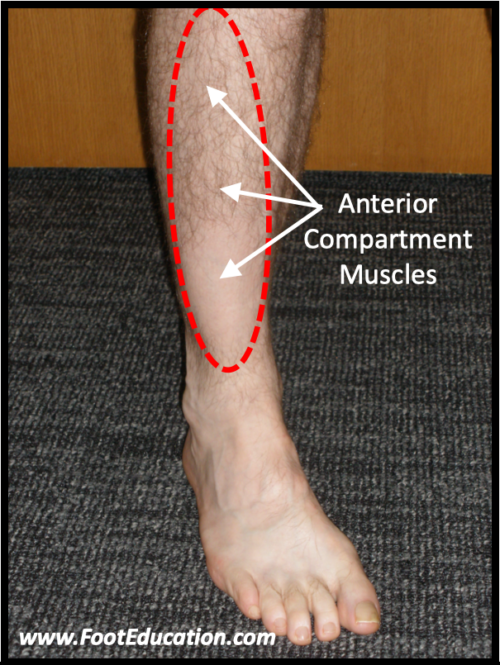Extensor Muscle Strain – Anterior Tibialis Strain
Summary
An anterior tibialis strain is a type of extensor muscle strain that causes pain in the front of the lower leg. It can occur following an acute injury, or from increased activity (ex. excessive walking or running) leading to repetitive microscopic muscle injury. Conservative treatment is usually effective. It involves an initial period of decreased activities to settle the symptoms. This is followed by a rehabilitation program designed to limited scar formation and regain muscle strength.
Background Information
Extensor muscle strain lead to pain in the muscles in the shin area (Figure 1) – also known as the extensor compartment. The muscles in this area include the tibial anterior, extensor, extensor hallucis longus (EHL), and the extensor digitorum longus (EDL). An anterior tibialis muscle strain is the most common extensor muscle affected. An injury to one or more of these muscles can be acute, leading to immediate localized pain –or it can result from repetitive overuse, leading to microscopic damage to the muscle tissue that produces pain that can progress over time.

The extensor compartment muscles function to lift the foot upwards, or allow the foot to slowly lower so that it does not slap on the ground when we walk. A loss of these extensor compartment muscles leads to a drop foot. The function of these extensor muscles is essential for normal walking and running. They need to contract in a coordinated manner with every step that we take. These repetitive muscle contractions can cause microscopic injury to the muscle tissue which can lead to localized discomfort and possible muscle scarring if the injured area is large enough. This type of extensor muscle strain occurs from repetitive muscle contraction. It tends to result from a dramatic increase in activity level.
If the anterior compartment muscle activity is markedly excessive, it is even possible for the local muscle injury to cause swelling of the muscles that may lead to an exercise induced compartment syndrome. A compartment syndrome in this area is a potentially urgent problem as it can lead to death of the involved muscle tissue. Fortunately, this scenario is uncommon relative to an extensor muscle strain.
Symptoms of an Anterior Tibialis Strain – Extensor Muscle Strain
Patient with an anterior tibialis muscle strain will give a history of a local injury to the muscle at the front of the lower leg, or describe an increase in activity. They will report pain which is localized to part of the muscles at the front of the lower leg. Often the tibialis anterior muscle is strained. This is the muscle right next to the shinbone (tibia). Pressing on this affected muscle area will produce localized discomfort. The muscle itself may be harder than a normal muscle, or there may be localized scar tissue that can be felt. Lifting the foot upwards, especially against resistance, will usually reproduce the discomfort. Walking will often be uncomfortable. Patients may walk with a limp. They may also notice that their leg fatigues quickly, and they will often experience pain with even a modest amount of walking.
It should be noted that if patients are unable to lift their foot up, or they have excruciating pain, when attempting to lift their foot upwards, it is important to rule out an extensor compartment syndrome. This is a serious condition that often requires urgent treatment do you prevent permanent muscle damage.
Imaging Studies
X-rays of the lower leg will be normal. If an MRI of the lower leg is performed localized edema, swelling may be noted in the anterior extensor compartment muscle area. In addition scar tissue surrounding the injured area may be identified.
Treatment of an Anterior Tibialis Muscle Strain
Pain from an extensor muscle strain can usually be treated effectively without surgery. It can be helpful to think about treatments in 4 phases.
Phase 1
The first phase of the treating a tibialis anterior muscle strain is to treat the acute symptoms. After an injury or the onset of symptoms the initial treatment should be focused on getting the pain and inflammation to settle. Stopping inciting activities and relatively immobilizing the affected leg can be helpful. Ice and elevation will also help improve the acute symptoms. For some patients crutches may be needed, but for most patients simply backing off on their activities will help settle the acute discomfort. Anti-inflammatory medication may also be helpful in the short term.
Phase 2
The second phase of treatment begins once the acute intense discomfort has settled. This treatment phase focuses on getting the muscles moving again –and allowing the injured area to settle while minimizing scar formation. The focus in this phase should be on gently stretching the muscles. This is combined with local massage of the muscle tissue or area of scarring. Activities will still need to be considerably limited during this phase. Working with physical therapy can be helpful during this phase of the recovery.
Phase 3
The third phase of treating a tibialis anterior strain starts when most of the symptoms have settled. The focus of this face is regaining the needed strength and stamina of the affected muscles. There is also an emphasis on local muscle and scar massage to limit the likelihood of any chronic symptoms from tissue scarring.
Maintenance Phase
The final phase of treatment is a maintenance phase. Depending upon the severity of the extensor muscle strain, it can take weeks or even months to reach this phase. At this point the patient is back to their regular activities. The maintenance phase is ongoing and should include regular exercises designed to keep the anterior compartment muscles stretched and strengthened. This will limit the likelihood of a recurrent injury, or symptoms from scarring in the extensor muscle compartment.
February 20th, 2024